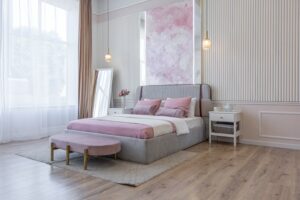Using colour psychology for a peaceful bedroom

According to colour psychology, bedroom palettes affect our mood and wellbeing. How does this work?
Your bedroom is more than just a place to sleep – it’s your personal sanctuary. Colours influence our emotions and by carefully selecting the right hues, you can create a space that feels naturally relaxing.
The power of calm
When it comes to designing a bedroom, the goal is to create a calming environment. Cool colours are known for their soothing qualities, making them ideal for a space dedicated to rest.
Blue
Blue is often associated with the tranquillity of the sea and sky. It can help lower blood pressure and reduce anxiety, making it an excellent choice for a bedroom. Soft shades like powder blue or duck egg create a serene atmosphere that encourages deep, revitalising sleep.
Green
Evoking the refreshing essence of nature, green is a colour that balances both body and mind. It’s known to reduce stress and boost relaxation, which is why it works so well in a bedroom. Sage or mint green can be particularly effective, offering a fresh, yet subdued backdrop that helps you unwind after a busy day.
Purple
Largely connected with luxury and creativity, lighter shades like lavender or lilac are ideal for creating a softer environment. These tones are particularly good for those who want a bedroom that feels both relaxing and slightly indulgent.
Welcoming warm tones
While cool colours are great for relaxation, warmer tones can introduce a sense of welcome and comfort, making your bedroom feel more intimate.
Neutrals
Shades like beige, taupe or soft greys are incredibly versatile and work beautifully in a bedroom. These colours make for a warm, cocoon-like atmosphere that feels inviting without being overpowering. They’re also a fantastic backdrop for other accent colours, allowing you to personalise your space with ease.
Soft pink
Linked to romance and tenderness, soft pink can bring a gentleness to your bedroom. It’s a great way to introduce a touch of colour without overwhelming the senses. Paired with neutral bedding and natural materials like wood or linen, soft pink can feel both modern and comforting.
Pale yellow
If you enjoy waking up to a bit of sunshine, pale yellow might be your perfect bedroom hue. This colour brings a subtle warmth and cheer to rooms, helping to start your day on a positive note. However, stick to softer shades to avoid creating a space that’s too energising to relax in.
The importance of harmony
It’s equally important to create an environment that doesn’t feel monotonous. The key is to mix your chosen colours with complementary tones and textures, adding splashes of depth and interest. For example, if you’ve opted for a predominantly blue bedroom, consider adding warm accents like cream or soft gold to prevent the space from feeling too cool. Similarly, a room dominated by neutrals can be brought to life with pops of colour in the form of cushions, throws or artwork.
At the end of the day, colour psychology is only a guide – the best bedroom is one where you can truly recharge and feel at peace!
Image Credit: ShutterStock











Comments